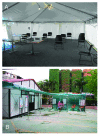SARS in healthcare facilities, Toronto and Taiwan
- PMID: 15200808
- PMCID: PMC3323242
- DOI: 10.3201/eid1005.030791
SARS in healthcare facilities, Toronto and Taiwan
Abstract
The healthcare setting was important in the early spread of severe acute respiratory syndrome (SARS) in both Toronto and Taiwan. Healthcare workers, patients, and visitors were at increased risk for infection. Nonetheless, the ability of individual SARS patients to transmit disease was quite variable. Unrecognized SARS case-patients were a primary source of transmission, and early detection and intervention were important to limit spread. Strict adherence to infection control precautions was essential in containing outbreaks. In addition, grouping patients into cohorts and limiting access to SARS patients minimized exposure opportunities. Given the difficulty in implementing several of these measures, control measures were frequently adapted to the acuity of SARS care and level of transmission within facilities. Although these conclusions are based only on a retrospective analysis of events, applying the experiences of Toronto and Taiwan to SARS preparedness planning efforts will likely minimize future transmission within healthcare facilities.
Figures


References
-
- World Health Organization. WHO issues a global alert about cases of atypical pneumonia: cases of severe respiratory illness may spread to hospital staff. [accessed 2004 Mar 4] Available from: http://www.who.int/csr/sars/archive/2003_03_12/en/
-
- Centers for Disease Control and Prevention. Severe acute respiratory syndrome—Taiwan, 2003. MMWR Morb Mortal Wkly Rep. 2003;52:461–6. - PubMed
Publication types
MeSH terms
LinkOut - more resources
Full Text Sources
Medical
Miscellaneous
